Researching Crime and Deviance: Methodologies, Findings and Ethics
VerifiedAdded on 2022/12/05
|8
|2041
|105
Report
AI Summary
This report provides an overview of two research studies related to crime and deviance. The first study, based on an MPhil thesis, investigates the impact of COVID-19 stigma and discrimination on Chinese/Asian communities, employing exploratory and quantitative research designs, including cross-sectional and online surveys. The study's findings reveal significant levels of job loss, verbal insults, and feelings of degradation among participants, alongside concerns about media representation and law enforcement effectiveness. Ethical considerations, such as risk assessment, transparency, and informed consent, were carefully addressed. The second study evaluates the Cure Violence model within a prison setting, utilizing both qualitative and quantitative research methods, including semi-structured interviews and observations. The report discusses the advantages and disadvantages of these methodologies, emphasizing the importance of understanding the program's impact from the perspectives of inmates and staff. The report concludes with a follow-up study proposal examining changes in discrimination against East Asian populations during and after the pandemic, outlining a descriptive research design, quantitative data collection via questionnaires and Facebook, and statistical analysis methods.
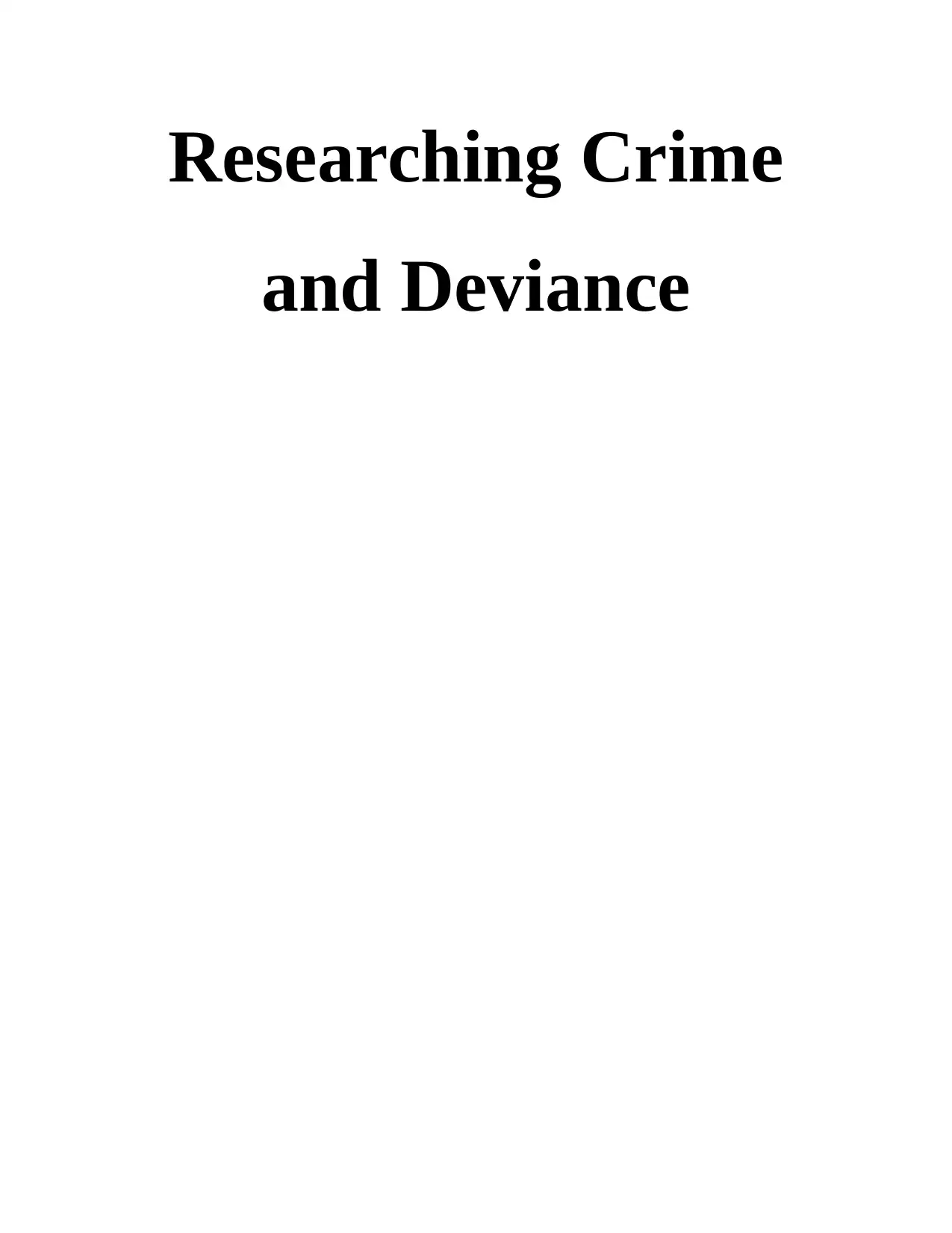
Researching Crime
and Deviance
and Deviance
Paraphrase This Document
Need a fresh take? Get an instant paraphrase of this document with our AI Paraphraser
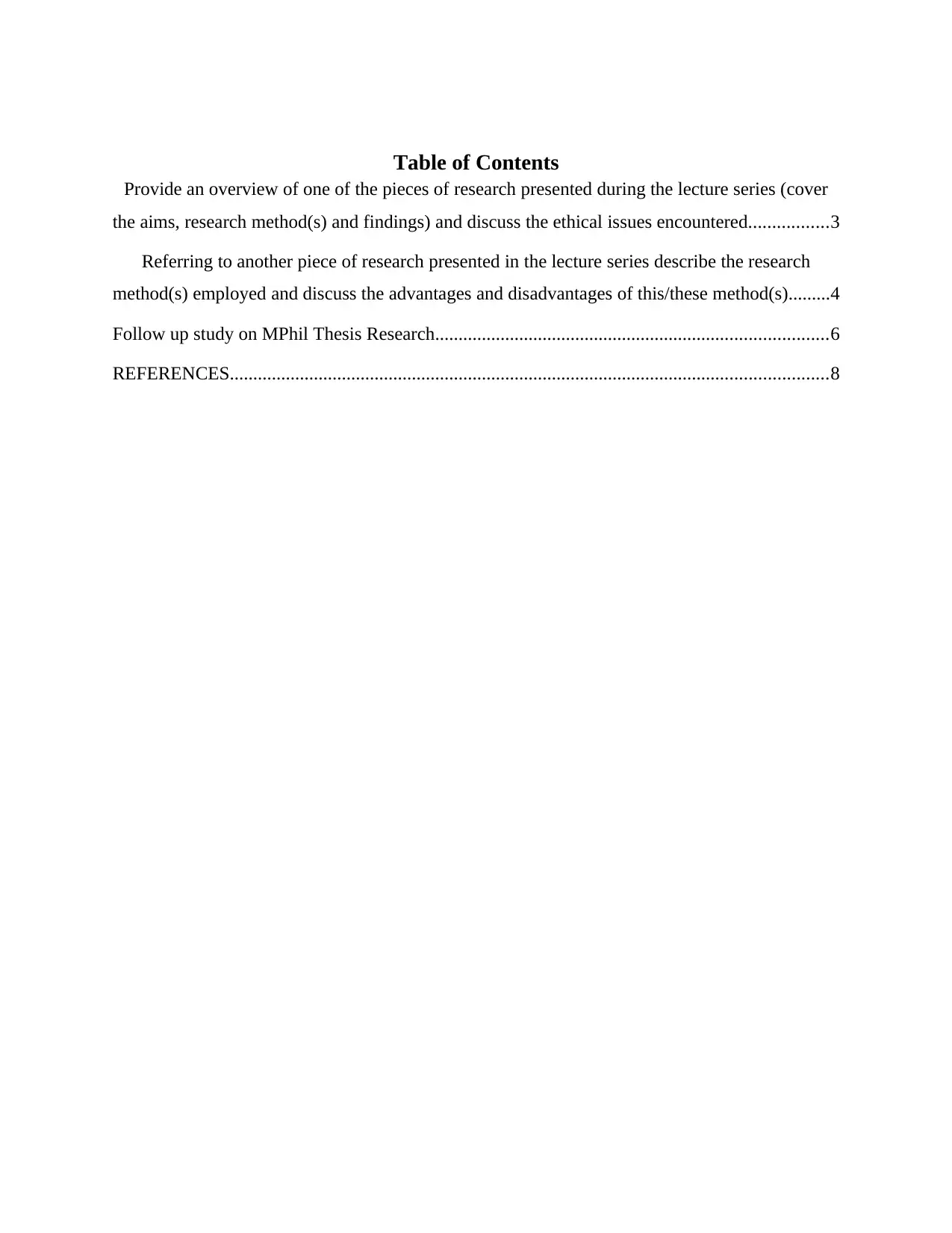
Table of Contents
Provide an overview of one of the pieces of research presented during the lecture series (cover
the aims, research method(s) and findings) and discuss the ethical issues encountered.................3
Referring to another piece of research presented in the lecture series describe the research
method(s) employed and discuss the advantages and disadvantages of this/these method(s).........4
Follow up study on MPhil Thesis Research....................................................................................6
REFERENCES................................................................................................................................8
Provide an overview of one of the pieces of research presented during the lecture series (cover
the aims, research method(s) and findings) and discuss the ethical issues encountered.................3
Referring to another piece of research presented in the lecture series describe the research
method(s) employed and discuss the advantages and disadvantages of this/these method(s).........4
Follow up study on MPhil Thesis Research....................................................................................6
REFERENCES................................................................................................................................8
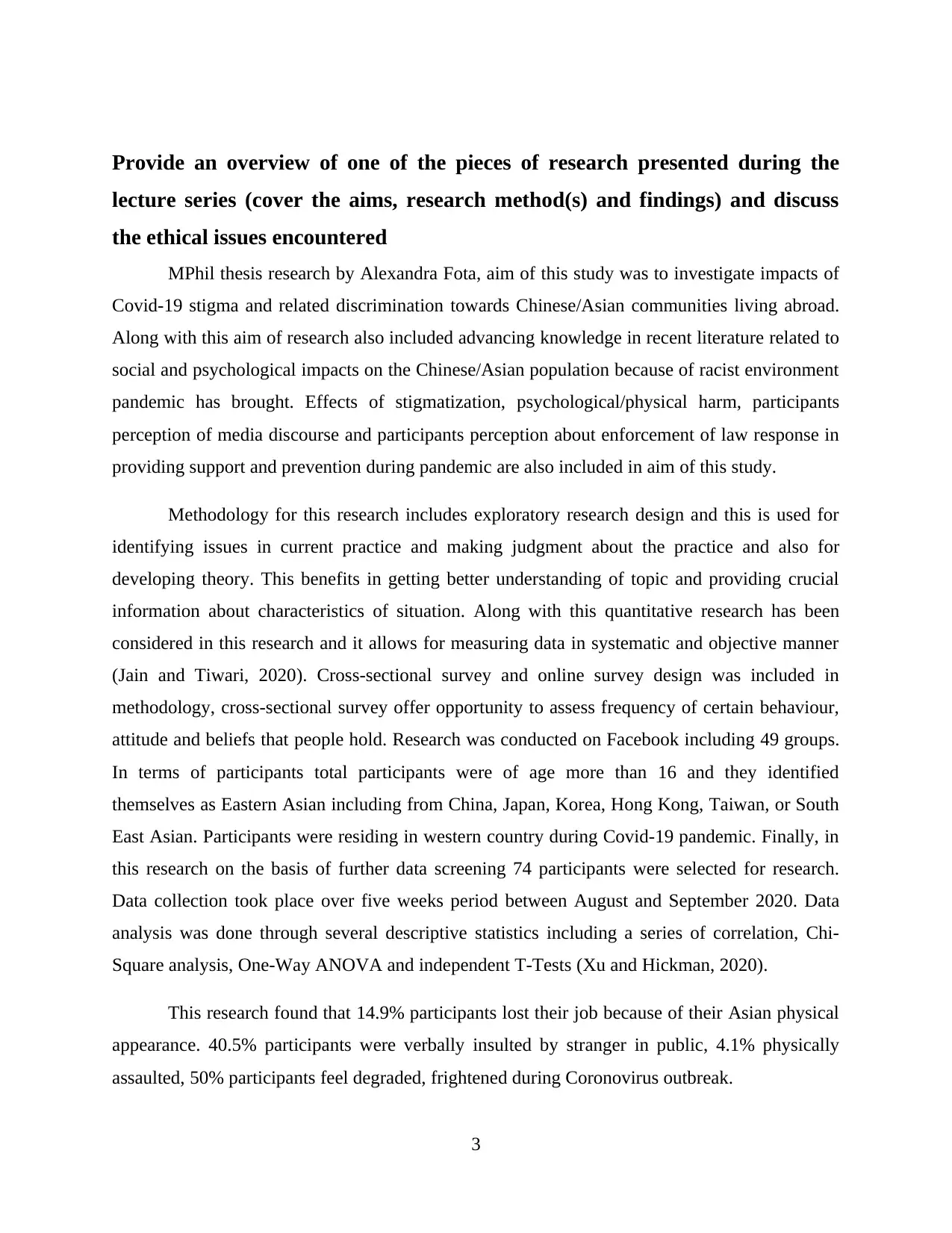
Provide an overview of one of the pieces of research presented during the
lecture series (cover the aims, research method(s) and findings) and discuss
the ethical issues encountered
MPhil thesis research by Alexandra Fota, aim of this study was to investigate impacts of
Covid-19 stigma and related discrimination towards Chinese/Asian communities living abroad.
Along with this aim of research also included advancing knowledge in recent literature related to
social and psychological impacts on the Chinese/Asian population because of racist environment
pandemic has brought. Effects of stigmatization, psychological/physical harm, participants
perception of media discourse and participants perception about enforcement of law response in
providing support and prevention during pandemic are also included in aim of this study.
Methodology for this research includes exploratory research design and this is used for
identifying issues in current practice and making judgment about the practice and also for
developing theory. This benefits in getting better understanding of topic and providing crucial
information about characteristics of situation. Along with this quantitative research has been
considered in this research and it allows for measuring data in systematic and objective manner
(Jain and Tiwari, 2020). Cross-sectional survey and online survey design was included in
methodology, cross-sectional survey offer opportunity to assess frequency of certain behaviour,
attitude and beliefs that people hold. Research was conducted on Facebook including 49 groups.
In terms of participants total participants were of age more than 16 and they identified
themselves as Eastern Asian including from China, Japan, Korea, Hong Kong, Taiwan, or South
East Asian. Participants were residing in western country during Covid-19 pandemic. Finally, in
this research on the basis of further data screening 74 participants were selected for research.
Data collection took place over five weeks period between August and September 2020. Data
analysis was done through several descriptive statistics including a series of correlation, Chi-
Square analysis, One-Way ANOVA and independent T-Tests (Xu and Hickman, 2020).
This research found that 14.9% participants lost their job because of their Asian physical
appearance. 40.5% participants were verbally insulted by stranger in public, 4.1% physically
assaulted, 50% participants feel degraded, frightened during Coronovirus outbreak.
3
lecture series (cover the aims, research method(s) and findings) and discuss
the ethical issues encountered
MPhil thesis research by Alexandra Fota, aim of this study was to investigate impacts of
Covid-19 stigma and related discrimination towards Chinese/Asian communities living abroad.
Along with this aim of research also included advancing knowledge in recent literature related to
social and psychological impacts on the Chinese/Asian population because of racist environment
pandemic has brought. Effects of stigmatization, psychological/physical harm, participants
perception of media discourse and participants perception about enforcement of law response in
providing support and prevention during pandemic are also included in aim of this study.
Methodology for this research includes exploratory research design and this is used for
identifying issues in current practice and making judgment about the practice and also for
developing theory. This benefits in getting better understanding of topic and providing crucial
information about characteristics of situation. Along with this quantitative research has been
considered in this research and it allows for measuring data in systematic and objective manner
(Jain and Tiwari, 2020). Cross-sectional survey and online survey design was included in
methodology, cross-sectional survey offer opportunity to assess frequency of certain behaviour,
attitude and beliefs that people hold. Research was conducted on Facebook including 49 groups.
In terms of participants total participants were of age more than 16 and they identified
themselves as Eastern Asian including from China, Japan, Korea, Hong Kong, Taiwan, or South
East Asian. Participants were residing in western country during Covid-19 pandemic. Finally, in
this research on the basis of further data screening 74 participants were selected for research.
Data collection took place over five weeks period between August and September 2020. Data
analysis was done through several descriptive statistics including a series of correlation, Chi-
Square analysis, One-Way ANOVA and independent T-Tests (Xu and Hickman, 2020).
This research found that 14.9% participants lost their job because of their Asian physical
appearance. 40.5% participants were verbally insulted by stranger in public, 4.1% physically
assaulted, 50% participants feel degraded, frightened during Coronovirus outbreak.
3
⊘ This is a preview!⊘
Do you want full access?
Subscribe today to unlock all pages.

Trusted by 1+ million students worldwide
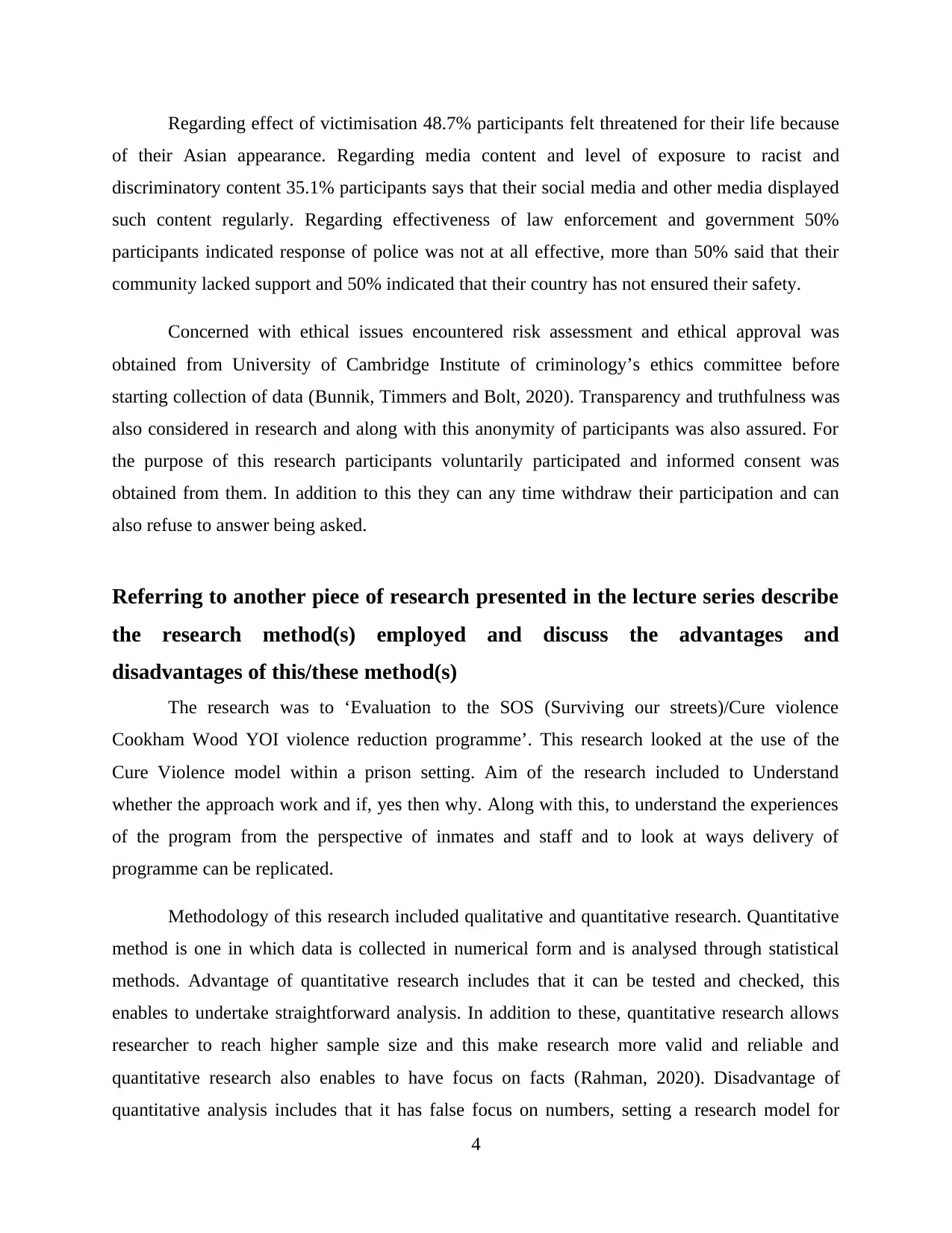
Regarding effect of victimisation 48.7% participants felt threatened for their life because
of their Asian appearance. Regarding media content and level of exposure to racist and
discriminatory content 35.1% participants says that their social media and other media displayed
such content regularly. Regarding effectiveness of law enforcement and government 50%
participants indicated response of police was not at all effective, more than 50% said that their
community lacked support and 50% indicated that their country has not ensured their safety.
Concerned with ethical issues encountered risk assessment and ethical approval was
obtained from University of Cambridge Institute of criminology’s ethics committee before
starting collection of data (Bunnik, Timmers and Bolt, 2020). Transparency and truthfulness was
also considered in research and along with this anonymity of participants was also assured. For
the purpose of this research participants voluntarily participated and informed consent was
obtained from them. In addition to this they can any time withdraw their participation and can
also refuse to answer being asked.
Referring to another piece of research presented in the lecture series describe
the research method(s) employed and discuss the advantages and
disadvantages of this/these method(s)
The research was to ‘Evaluation to the SOS (Surviving our streets)/Cure violence
Cookham Wood YOI violence reduction programme’. This research looked at the use of the
Cure Violence model within a prison setting. Aim of the research included to Understand
whether the approach work and if, yes then why. Along with this, to understand the experiences
of the program from the perspective of inmates and staff and to look at ways delivery of
programme can be replicated.
Methodology of this research included qualitative and quantitative research. Quantitative
method is one in which data is collected in numerical form and is analysed through statistical
methods. Advantage of quantitative research includes that it can be tested and checked, this
enables to undertake straightforward analysis. In addition to these, quantitative research allows
researcher to reach higher sample size and this make research more valid and reliable and
quantitative research also enables to have focus on facts (Rahman, 2020). Disadvantage of
quantitative analysis includes that it has false focus on numbers, setting a research model for
4
of their Asian appearance. Regarding media content and level of exposure to racist and
discriminatory content 35.1% participants says that their social media and other media displayed
such content regularly. Regarding effectiveness of law enforcement and government 50%
participants indicated response of police was not at all effective, more than 50% said that their
community lacked support and 50% indicated that their country has not ensured their safety.
Concerned with ethical issues encountered risk assessment and ethical approval was
obtained from University of Cambridge Institute of criminology’s ethics committee before
starting collection of data (Bunnik, Timmers and Bolt, 2020). Transparency and truthfulness was
also considered in research and along with this anonymity of participants was also assured. For
the purpose of this research participants voluntarily participated and informed consent was
obtained from them. In addition to this they can any time withdraw their participation and can
also refuse to answer being asked.
Referring to another piece of research presented in the lecture series describe
the research method(s) employed and discuss the advantages and
disadvantages of this/these method(s)
The research was to ‘Evaluation to the SOS (Surviving our streets)/Cure violence
Cookham Wood YOI violence reduction programme’. This research looked at the use of the
Cure Violence model within a prison setting. Aim of the research included to Understand
whether the approach work and if, yes then why. Along with this, to understand the experiences
of the program from the perspective of inmates and staff and to look at ways delivery of
programme can be replicated.
Methodology of this research included qualitative and quantitative research. Quantitative
method is one in which data is collected in numerical form and is analysed through statistical
methods. Advantage of quantitative research includes that it can be tested and checked, this
enables to undertake straightforward analysis. In addition to these, quantitative research allows
researcher to reach higher sample size and this make research more valid and reliable and
quantitative research also enables to have focus on facts (Rahman, 2020). Disadvantage of
quantitative analysis includes that it has false focus on numbers, setting a research model for
4
Paraphrase This Document
Need a fresh take? Get an instant paraphrase of this document with our AI Paraphraser
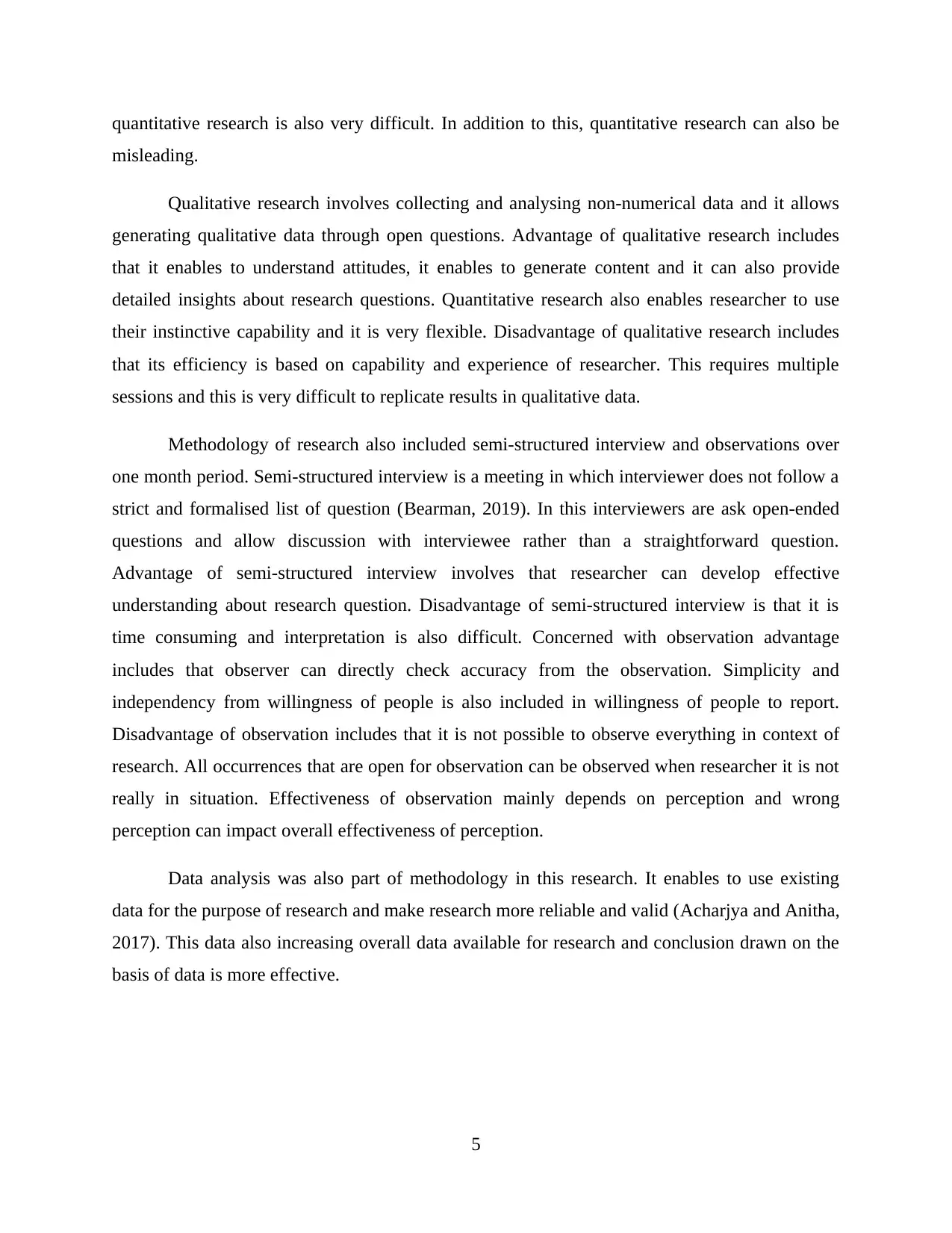
quantitative research is also very difficult. In addition to this, quantitative research can also be
misleading.
Qualitative research involves collecting and analysing non-numerical data and it allows
generating qualitative data through open questions. Advantage of qualitative research includes
that it enables to understand attitudes, it enables to generate content and it can also provide
detailed insights about research questions. Quantitative research also enables researcher to use
their instinctive capability and it is very flexible. Disadvantage of qualitative research includes
that its efficiency is based on capability and experience of researcher. This requires multiple
sessions and this is very difficult to replicate results in qualitative data.
Methodology of research also included semi-structured interview and observations over
one month period. Semi-structured interview is a meeting in which interviewer does not follow a
strict and formalised list of question (Bearman, 2019). In this interviewers are ask open-ended
questions and allow discussion with interviewee rather than a straightforward question.
Advantage of semi-structured interview involves that researcher can develop effective
understanding about research question. Disadvantage of semi-structured interview is that it is
time consuming and interpretation is also difficult. Concerned with observation advantage
includes that observer can directly check accuracy from the observation. Simplicity and
independency from willingness of people is also included in willingness of people to report.
Disadvantage of observation includes that it is not possible to observe everything in context of
research. All occurrences that are open for observation can be observed when researcher it is not
really in situation. Effectiveness of observation mainly depends on perception and wrong
perception can impact overall effectiveness of perception.
Data analysis was also part of methodology in this research. It enables to use existing
data for the purpose of research and make research more reliable and valid (Acharjya and Anitha,
2017). This data also increasing overall data available for research and conclusion drawn on the
basis of data is more effective.
5
misleading.
Qualitative research involves collecting and analysing non-numerical data and it allows
generating qualitative data through open questions. Advantage of qualitative research includes
that it enables to understand attitudes, it enables to generate content and it can also provide
detailed insights about research questions. Quantitative research also enables researcher to use
their instinctive capability and it is very flexible. Disadvantage of qualitative research includes
that its efficiency is based on capability and experience of researcher. This requires multiple
sessions and this is very difficult to replicate results in qualitative data.
Methodology of research also included semi-structured interview and observations over
one month period. Semi-structured interview is a meeting in which interviewer does not follow a
strict and formalised list of question (Bearman, 2019). In this interviewers are ask open-ended
questions and allow discussion with interviewee rather than a straightforward question.
Advantage of semi-structured interview involves that researcher can develop effective
understanding about research question. Disadvantage of semi-structured interview is that it is
time consuming and interpretation is also difficult. Concerned with observation advantage
includes that observer can directly check accuracy from the observation. Simplicity and
independency from willingness of people is also included in willingness of people to report.
Disadvantage of observation includes that it is not possible to observe everything in context of
research. All occurrences that are open for observation can be observed when researcher it is not
really in situation. Effectiveness of observation mainly depends on perception and wrong
perception can impact overall effectiveness of perception.
Data analysis was also part of methodology in this research. It enables to use existing
data for the purpose of research and make research more reliable and valid (Acharjya and Anitha,
2017). This data also increasing overall data available for research and conclusion drawn on the
basis of data is more effective.
5
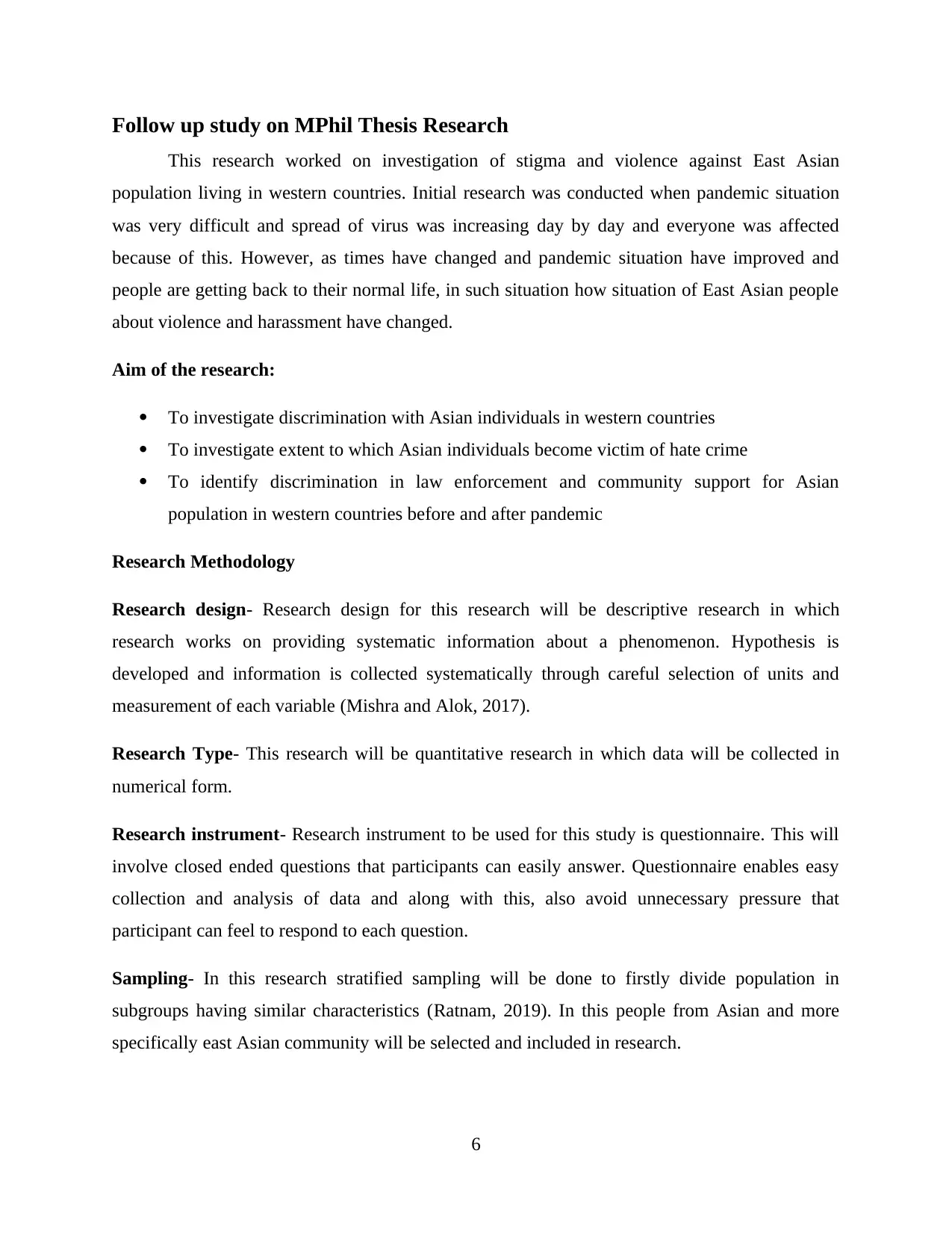
Follow up study on MPhil Thesis Research
This research worked on investigation of stigma and violence against East Asian
population living in western countries. Initial research was conducted when pandemic situation
was very difficult and spread of virus was increasing day by day and everyone was affected
because of this. However, as times have changed and pandemic situation have improved and
people are getting back to their normal life, in such situation how situation of East Asian people
about violence and harassment have changed.
Aim of the research:
To investigate discrimination with Asian individuals in western countries
To investigate extent to which Asian individuals become victim of hate crime
To identify discrimination in law enforcement and community support for Asian
population in western countries before and after pandemic
Research Methodology
Research design- Research design for this research will be descriptive research in which
research works on providing systematic information about a phenomenon. Hypothesis is
developed and information is collected systematically through careful selection of units and
measurement of each variable (Mishra and Alok, 2017).
Research Type- This research will be quantitative research in which data will be collected in
numerical form.
Research instrument- Research instrument to be used for this study is questionnaire. This will
involve closed ended questions that participants can easily answer. Questionnaire enables easy
collection and analysis of data and along with this, also avoid unnecessary pressure that
participant can feel to respond to each question.
Sampling- In this research stratified sampling will be done to firstly divide population in
subgroups having similar characteristics (Ratnam, 2019). In this people from Asian and more
specifically east Asian community will be selected and included in research.
6
This research worked on investigation of stigma and violence against East Asian
population living in western countries. Initial research was conducted when pandemic situation
was very difficult and spread of virus was increasing day by day and everyone was affected
because of this. However, as times have changed and pandemic situation have improved and
people are getting back to their normal life, in such situation how situation of East Asian people
about violence and harassment have changed.
Aim of the research:
To investigate discrimination with Asian individuals in western countries
To investigate extent to which Asian individuals become victim of hate crime
To identify discrimination in law enforcement and community support for Asian
population in western countries before and after pandemic
Research Methodology
Research design- Research design for this research will be descriptive research in which
research works on providing systematic information about a phenomenon. Hypothesis is
developed and information is collected systematically through careful selection of units and
measurement of each variable (Mishra and Alok, 2017).
Research Type- This research will be quantitative research in which data will be collected in
numerical form.
Research instrument- Research instrument to be used for this study is questionnaire. This will
involve closed ended questions that participants can easily answer. Questionnaire enables easy
collection and analysis of data and along with this, also avoid unnecessary pressure that
participant can feel to respond to each question.
Sampling- In this research stratified sampling will be done to firstly divide population in
subgroups having similar characteristics (Ratnam, 2019). In this people from Asian and more
specifically east Asian community will be selected and included in research.
6
⊘ This is a preview!⊘
Do you want full access?
Subscribe today to unlock all pages.

Trusted by 1+ million students worldwide
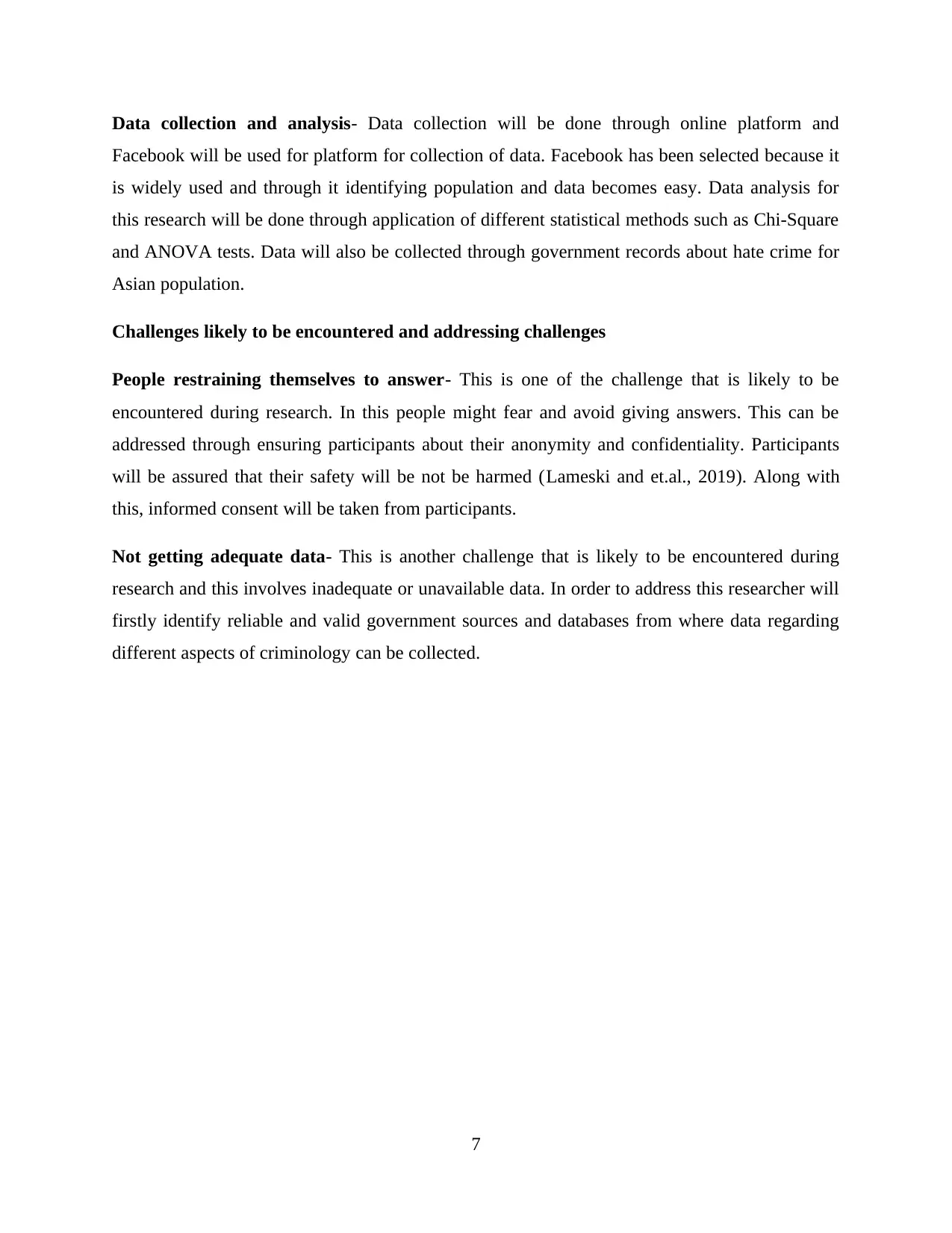
Data collection and analysis- Data collection will be done through online platform and
Facebook will be used for platform for collection of data. Facebook has been selected because it
is widely used and through it identifying population and data becomes easy. Data analysis for
this research will be done through application of different statistical methods such as Chi-Square
and ANOVA tests. Data will also be collected through government records about hate crime for
Asian population.
Challenges likely to be encountered and addressing challenges
People restraining themselves to answer- This is one of the challenge that is likely to be
encountered during research. In this people might fear and avoid giving answers. This can be
addressed through ensuring participants about their anonymity and confidentiality. Participants
will be assured that their safety will be not be harmed (Lameski and et.al., 2019). Along with
this, informed consent will be taken from participants.
Not getting adequate data- This is another challenge that is likely to be encountered during
research and this involves inadequate or unavailable data. In order to address this researcher will
firstly identify reliable and valid government sources and databases from where data regarding
different aspects of criminology can be collected.
7
Facebook will be used for platform for collection of data. Facebook has been selected because it
is widely used and through it identifying population and data becomes easy. Data analysis for
this research will be done through application of different statistical methods such as Chi-Square
and ANOVA tests. Data will also be collected through government records about hate crime for
Asian population.
Challenges likely to be encountered and addressing challenges
People restraining themselves to answer- This is one of the challenge that is likely to be
encountered during research. In this people might fear and avoid giving answers. This can be
addressed through ensuring participants about their anonymity and confidentiality. Participants
will be assured that their safety will be not be harmed (Lameski and et.al., 2019). Along with
this, informed consent will be taken from participants.
Not getting adequate data- This is another challenge that is likely to be encountered during
research and this involves inadequate or unavailable data. In order to address this researcher will
firstly identify reliable and valid government sources and databases from where data regarding
different aspects of criminology can be collected.
7
Paraphrase This Document
Need a fresh take? Get an instant paraphrase of this document with our AI Paraphraser
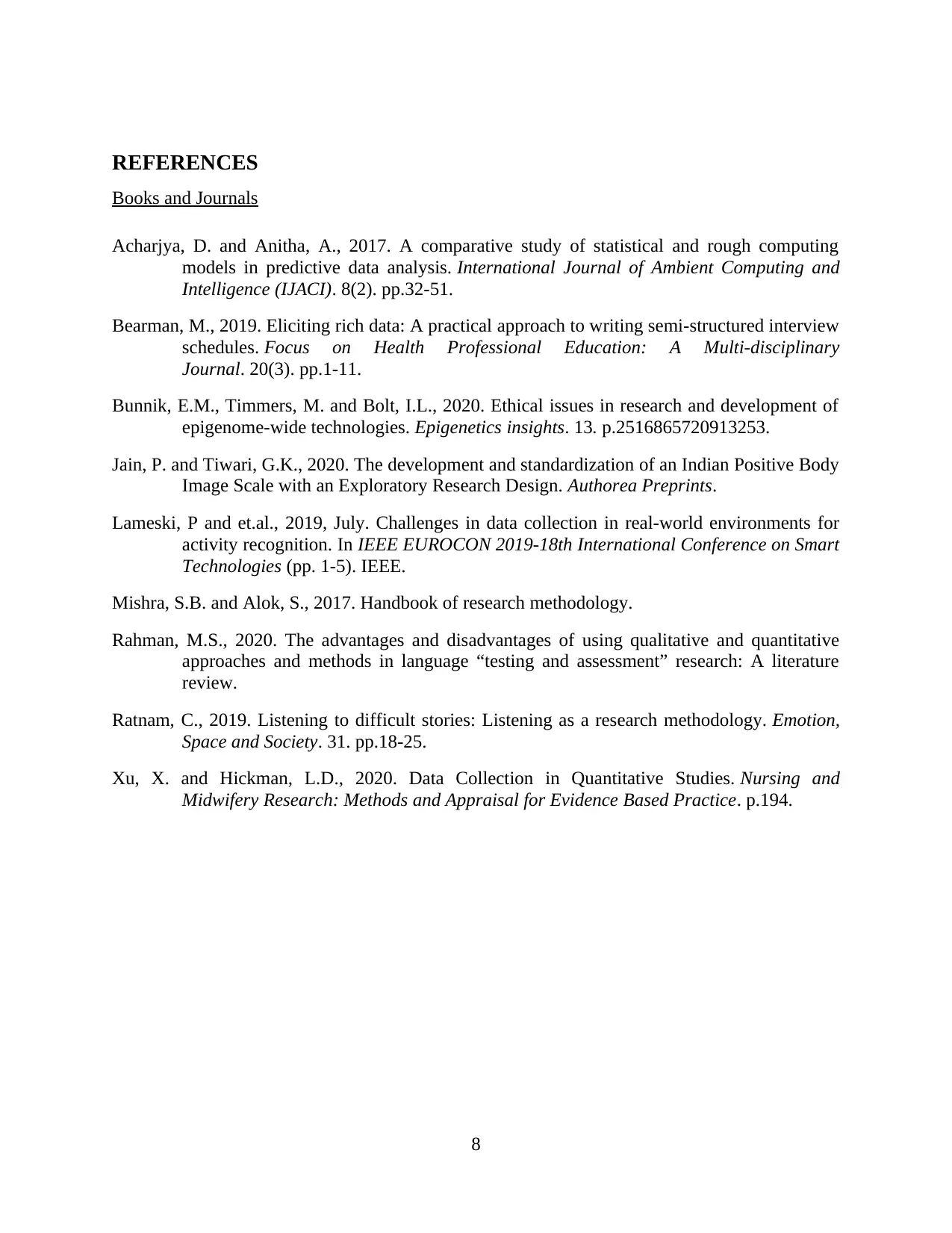
REFERENCES
Books and Journals
Acharjya, D. and Anitha, A., 2017. A comparative study of statistical and rough computing
models in predictive data analysis. International Journal of Ambient Computing and
Intelligence (IJACI). 8(2). pp.32-51.
Bearman, M., 2019. Eliciting rich data: A practical approach to writing semi-structured interview
schedules. Focus on Health Professional Education: A Multi-disciplinary
Journal. 20(3). pp.1-11.
Bunnik, E.M., Timmers, M. and Bolt, I.L., 2020. Ethical issues in research and development of
epigenome-wide technologies. Epigenetics insights. 13. p.2516865720913253.
Jain, P. and Tiwari, G.K., 2020. The development and standardization of an Indian Positive Body
Image Scale with an Exploratory Research Design. Authorea Preprints.
Lameski, P and et.al., 2019, July. Challenges in data collection in real-world environments for
activity recognition. In IEEE EUROCON 2019-18th International Conference on Smart
Technologies (pp. 1-5). IEEE.
Mishra, S.B. and Alok, S., 2017. Handbook of research methodology.
Rahman, M.S., 2020. The advantages and disadvantages of using qualitative and quantitative
approaches and methods in language “testing and assessment” research: A literature
review.
Ratnam, C., 2019. Listening to difficult stories: Listening as a research methodology. Emotion,
Space and Society. 31. pp.18-25.
Xu, X. and Hickman, L.D., 2020. Data Collection in Quantitative Studies. Nursing and
Midwifery Research: Methods and Appraisal for Evidence Based Practice. p.194.
8
Books and Journals
Acharjya, D. and Anitha, A., 2017. A comparative study of statistical and rough computing
models in predictive data analysis. International Journal of Ambient Computing and
Intelligence (IJACI). 8(2). pp.32-51.
Bearman, M., 2019. Eliciting rich data: A practical approach to writing semi-structured interview
schedules. Focus on Health Professional Education: A Multi-disciplinary
Journal. 20(3). pp.1-11.
Bunnik, E.M., Timmers, M. and Bolt, I.L., 2020. Ethical issues in research and development of
epigenome-wide technologies. Epigenetics insights. 13. p.2516865720913253.
Jain, P. and Tiwari, G.K., 2020. The development and standardization of an Indian Positive Body
Image Scale with an Exploratory Research Design. Authorea Preprints.
Lameski, P and et.al., 2019, July. Challenges in data collection in real-world environments for
activity recognition. In IEEE EUROCON 2019-18th International Conference on Smart
Technologies (pp. 1-5). IEEE.
Mishra, S.B. and Alok, S., 2017. Handbook of research methodology.
Rahman, M.S., 2020. The advantages and disadvantages of using qualitative and quantitative
approaches and methods in language “testing and assessment” research: A literature
review.
Ratnam, C., 2019. Listening to difficult stories: Listening as a research methodology. Emotion,
Space and Society. 31. pp.18-25.
Xu, X. and Hickman, L.D., 2020. Data Collection in Quantitative Studies. Nursing and
Midwifery Research: Methods and Appraisal for Evidence Based Practice. p.194.
8
1 out of 8
Related Documents
Your All-in-One AI-Powered Toolkit for Academic Success.
+13062052269
info@desklib.com
Available 24*7 on WhatsApp / Email
![[object Object]](/_next/static/media/star-bottom.7253800d.svg)
Unlock your academic potential
Copyright © 2020–2025 A2Z Services. All Rights Reserved. Developed and managed by ZUCOL.





